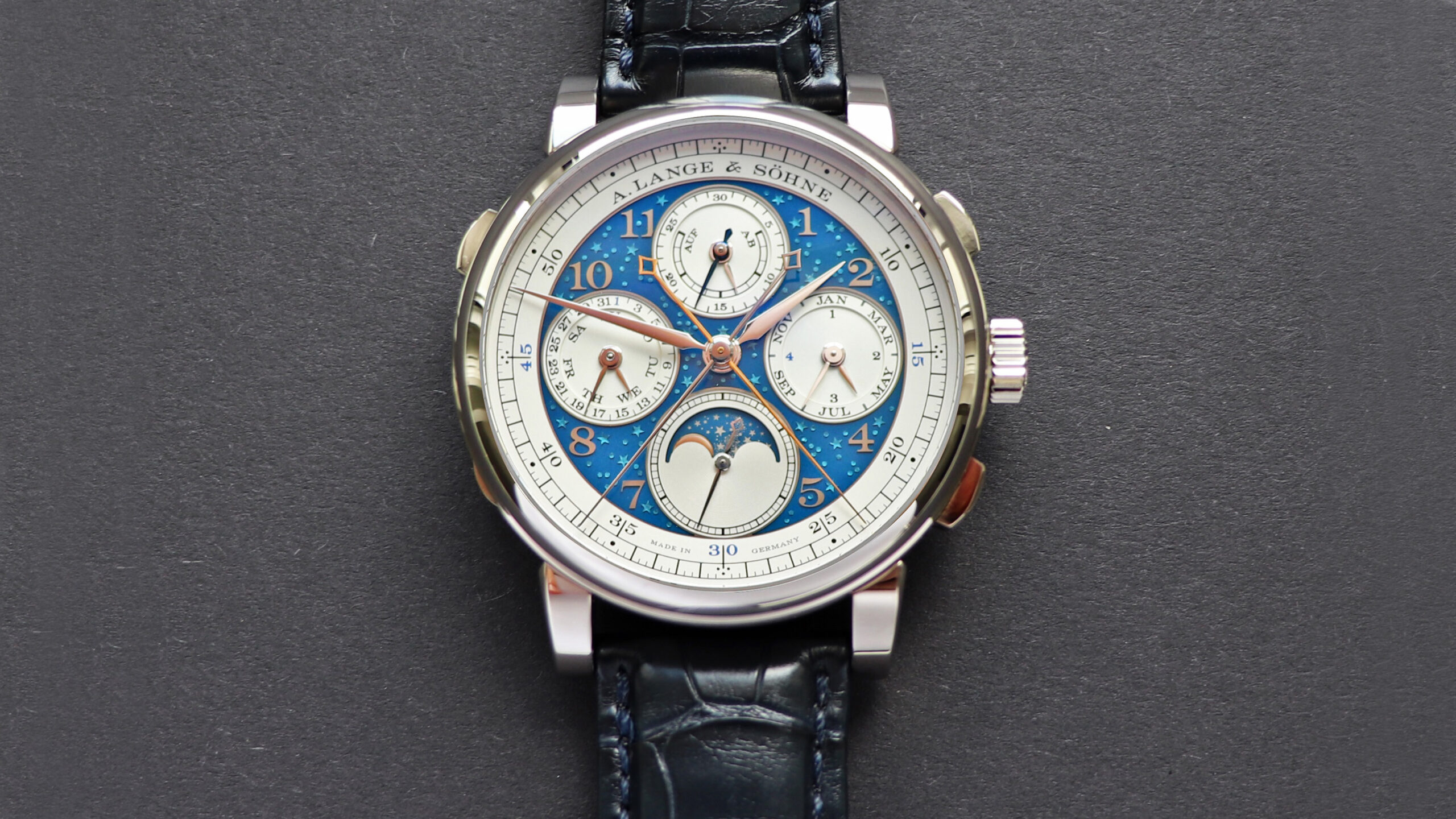
A. Lange & Söhne 1815 Rattrapante Perpetual Calendar
April 2020. Updated April 2024.
There are complications that every manufacturé should master to claim a seat in the roundtable of knights. When combined, these complications form a traditional grand complication, which many manufacturés in the 90s crafted for the flexing contest: The Split Seconds chronograph, perpetual calendar and repeater. A. Lange & Söhne had never been a powerhouse on the third one, albeit had a proven track-record for the first two. The combination of those however only arrived in 2013 with an overtly traditional timepiece: 1815 Rattrapante Perpetual Calendar.
Quick Facts:
- Introduced in 2013
- Measures 41.9 mm in diameter and 14.7 mm in thickness.
- Available in gold and platinum
- Part of the Handwerkskunst Collection
- In production as of 2023
The 1815 Rattrapante Perpetual Calendar is perhaps the closest one can get to a pocket watch appearance from A. Lange & Söhne, aside from the Grand Complication, which is a replica of a pocket watch itself. This piece just doesn’t offer any innovation or novelty, neither in terms of design nor technicality. However, there might be a very much valid reason and charm exactly in this archaic construct, which we are going to explore together below.
At the 2013 SIHH, A. Lange & Söhne unveiled the Grand Complication, a timepiece that combines rattrapante, perpetual calendar, Sonnerie, and repeater functions based on a pocket watch mechanism crafted by Louis Audemars back in the 1900s. Unfortunately, I’ve never seen Lange’s Grand Complication at a level I would truly admire. The watch measures a hefty 50 mm in diameter and 20 mm in thickness, far from a technical marvel considering the modern manufacturing capabilities. Moreover, it’s impractical as a wristwatch. Alongside this impressive ensemble, A. Lange & Söhne introduced the 1815 Rattrapante Perpetual Calendar, offered in a more wearable size with almost identical aesthetics, perhaps serving as a consolation prize for those unable to reach the €1.9 million Grand Complication.

Grand Complication (left) vs its more reachable sibling
There are undoubtedly a handful of companies positioned in the market with the technical prowess to combine a split-seconds chronograph with a perpetual calendar. When considering such a complication, the first name that comes to mind is Patek Philippe with their reference 5004. It is also useful to note that this majestic combination was particularly trendy in the first half of the 90s, with intriguing offerings from Blancpain and IWC. Among these, the reference 5004, essentially a 3970 with a split-second chronograph module, measures a mere 36 x 15 mm, akin to a biscuit, while the latter two measure around 42 x 15 mm. Therefore, it’s fair to say that the sheer complexity of such combinations significantly sacrifices wearability, though it brings joy that only a select few can truly appreciate.
The 1815 Rattrapante Perpetual Calendar measures 41.9 mm in diameter and 14.7 mm in thickness. If you can comfortably wear a Rolex 126600 Sea-Dweller, you can also pull off this timepiece. However, I must mention that it’s not the most comfortable watch in the world, owing to its size and protruding case-back, a common trait among complicated A. Lange & Söhne watches. The good news is that a deployant clasp goes a long way in improving comfort!
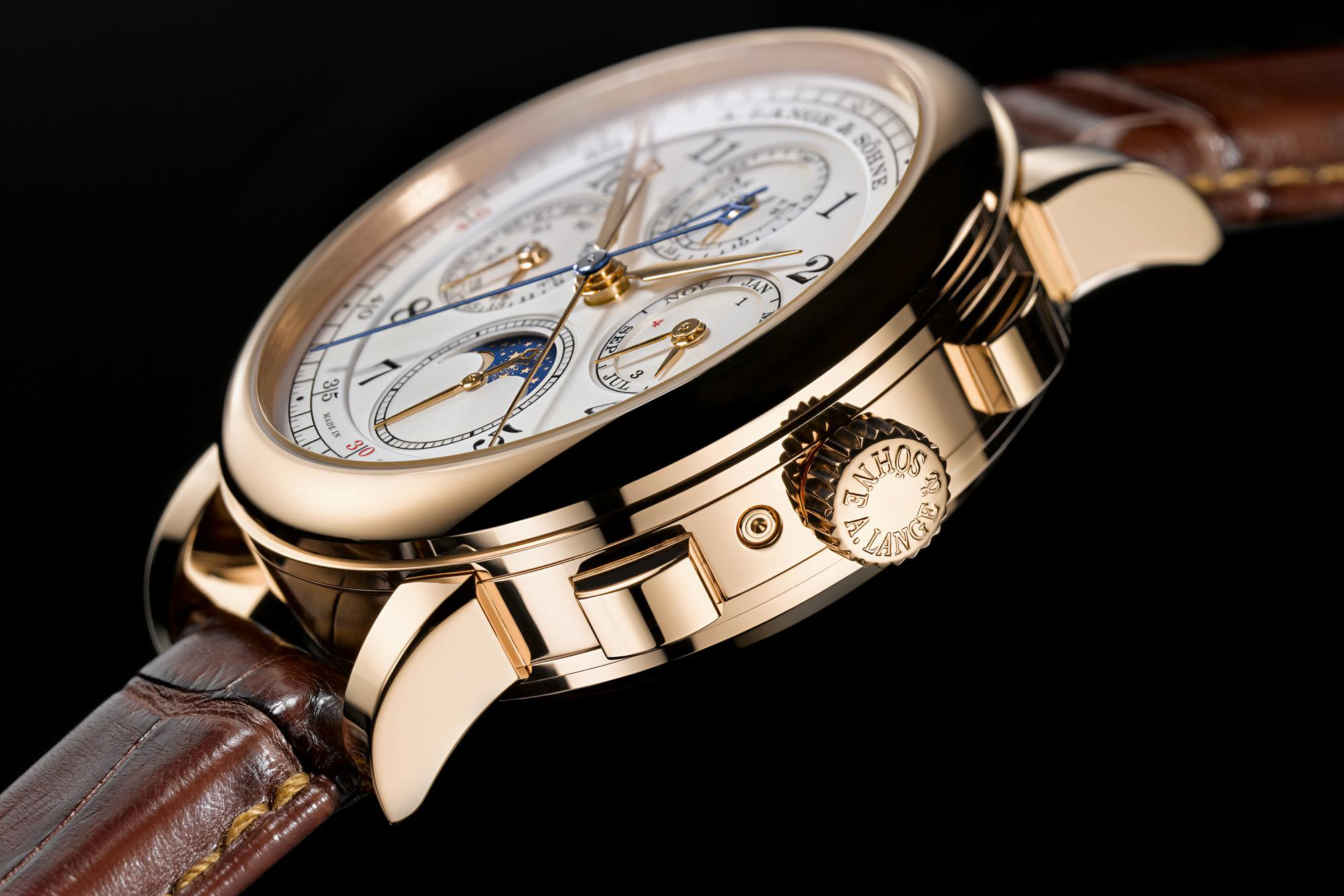
The fully polished band of the pink gold 1815 Rattrapante Perpetual. Courtesy of Lange Uhren GmbH
The case of the 1815 Rattrapante Perpetual Calendar is crafted in the signature A. Lange & Söhne style. Its construction comprises three distinct layers: the bezel, band, and case back. The bezel seamlessly meets the case-band with a step, tapering towards the top, a detail that diminishes the perception of thickness in the piece. In the pink gold version, each part is polished, while the platinum iteration showcases alternating finishing techniques and a brushed case-band. In my view, the brushed band offers a superior contrast with the notched, polished lugs and the other two layers. Despite the 1815 Rattrapante Perpetual Calendar’s romantic, old-world charm, I still believe that a white metal complements its engineered and non-Genevan case structure best.
The case of the 1815 Rattrapante Perpetual Calendar hosts three pushers for the split-seconds chronograph function and four recessed pushers for the calendar indications. These pushers feature beveling that aligns with the angle of the case, a delightful detail. The pusher at 2 o’clock initiates and halts the chronograph, while the pusher at 10 o’clock activates the rattrapante hand, and the one at 4 o’clock resets them, without the flyback function.
Moving onto the dial, I believe this is where the 1815 Rattrapante Perpetual Calendar faces a challenge—not from a visual standpoint, but from a philosophical one. Let me elaborate:
A. Lange & Söhne doesn’t boast the glamorous heritage of Patek Philippe or Vacheron Constantin. This is because A. Lange & Söhne was unable to realize its full potential due to the two world wars Germany endured within a mere 25-year period. From hyperinflation to sanctions, A. Lange & Söhne experienced a decline from the 1915s until its expropriation in the late 1940s. Consequently, the lack of a robust heritage compelled modern A. Lange & Söhne to strive for originality, distinctiveness, and freedom from its past. “Different” is the operative word here because, without meaningful differentiation, I doubt we would be discussing the brand today. The 1815 Rattrapante Perpetual Calendar either fails or succeeds right here, depending on your perspective.
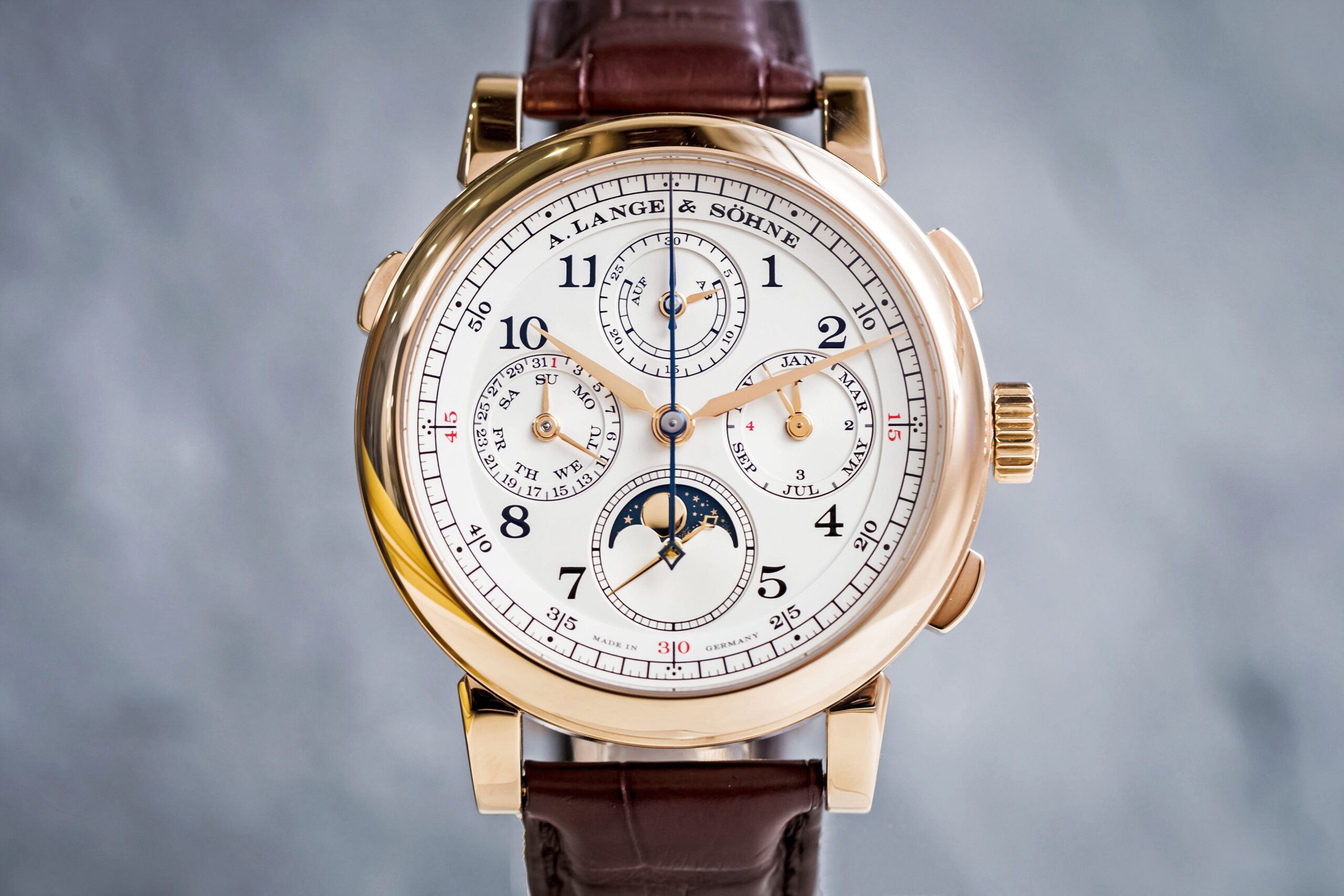
421.032 in full glory. Courtesy of WatchBox
It fails because the layout of the four sub-dials for the split-seconds perpetual calendar complications has been a standard for decades, from early pocket watches to the aforementioned IWC and Blancpains of the 1990s. Patek Philippe with the reference 5004 introduced a different flair to this combination. While I understand that the 1815 Rattrapante Perpetual Calendar was intended as an homage to old pocket watches, I struggle to align it with the A. Lange & Söhne philosophy I know—one that doesn’t blindly adhere to tradition and always seeks to innovate.
On the other hand, it succeeds because it’s a superbly executed timepiece from the 1815 collection. For someone who appreciates traditional designs and doesn’t have qualms about the watch’s heritage, the 1815 Rattrapante Perpetual Calendar could be the best option on the market. It’s a pocket watch of the 20th century impeccably adapted to the wrist, albeit perhaps missing only an enamel dial.
1815 Rattrapante Perpetual Calendar carries all of the hallmarks of the 1815 collection such as the rail-way minute track, three-dots on each 15-minute markers, red markers on each quarters, Arabic numerals, and layered dial structure. The chronograph and running seconds indications are fitted to the 12 and 6 o’clock positions whereas the calendar indications are placed at 3 and 9 o’clock, respectively. The touch of red brings so much of a liveliness to the dial, breaks the monochrome appearance successfully.
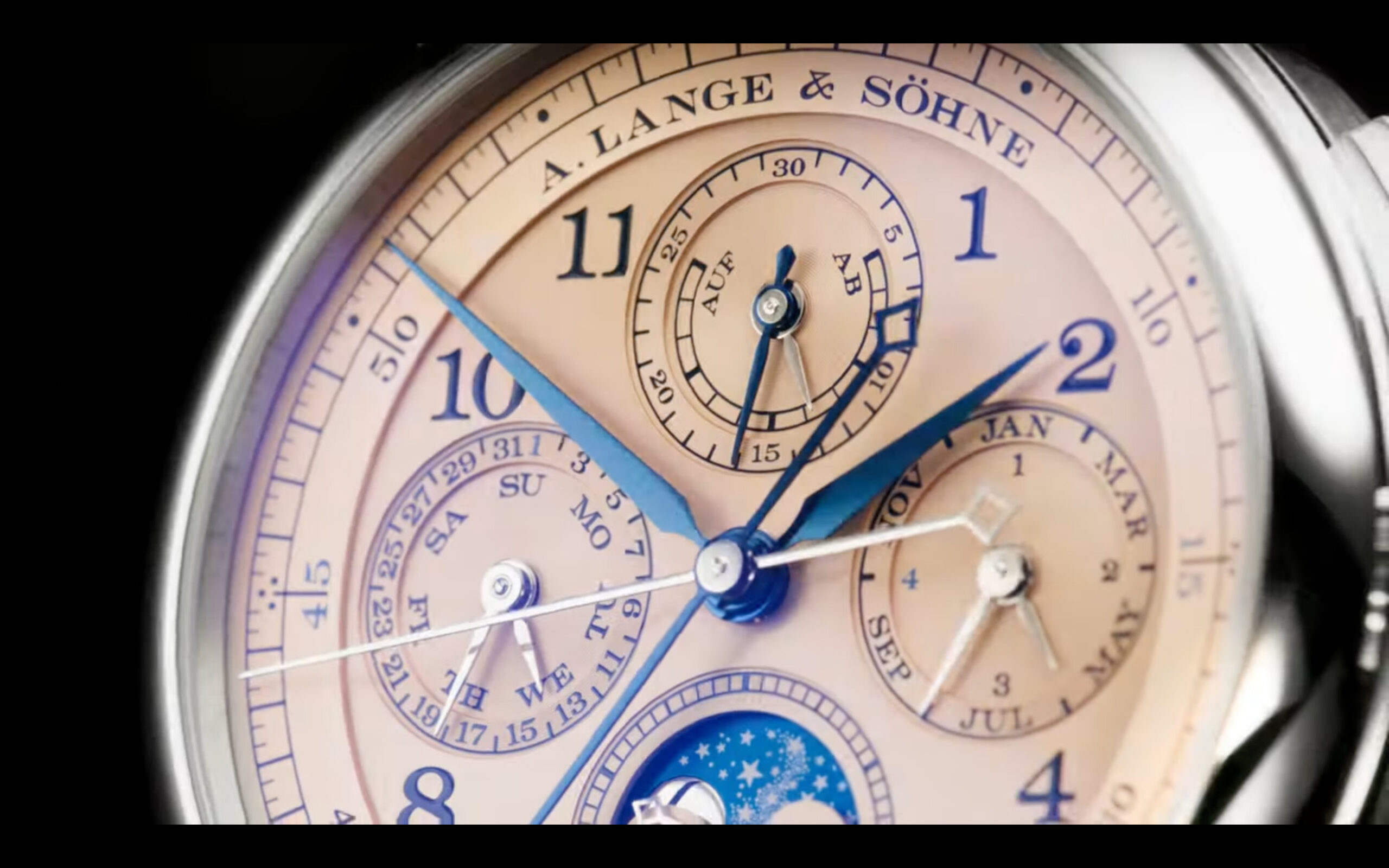
421.056, and its delightfully layered, thought out pink gold dial. Source: Lange Uhren Gmbh
Continuing, the outermost layer comprises the minute track, followed by a gentle step leading to the main dial where the hours are displayed. Another step reveals the layers for the month, date, and chronograph minute counter. At the deepest recess, we find the power reserve and Moon phase indications. Moreover, the presence of four overlapping hands adds immense depth to the dial, making it a joy to observe the piece from every angle.
The 1815 Rattrapante Perpetual Calendar references not only differ in case material but also in the metals used on the dial. The pink gold reference (421.032) features pink gold and blued steel hands, lending it a somewhat ostentatious and flashy appearance. In contrast, the platinum and white gold references feature rhodium-plated white gold and blued steel hands, giving off a calm and serious vibe. Considering there are 11 hands on the dial, along with a delightful Moon phase disc made of gold, I find the serene appearance of the platinum 1815 Rattrapante Perpetual Calendar a bit more appealing than its pink gold counterpart, though this is clearly a matter of taste.
However, the blue hue of the Moon phase disc is a delight in all references. Crafted from solid pink gold for the pink gold 1815 Rattrapante Perpetual Calendar and white gold for the others, it’s coated with a strong blue finish—which, I must admit, I find particularly enjoyable in the platinum 1815 Rattrapante Perpetual Calendar.
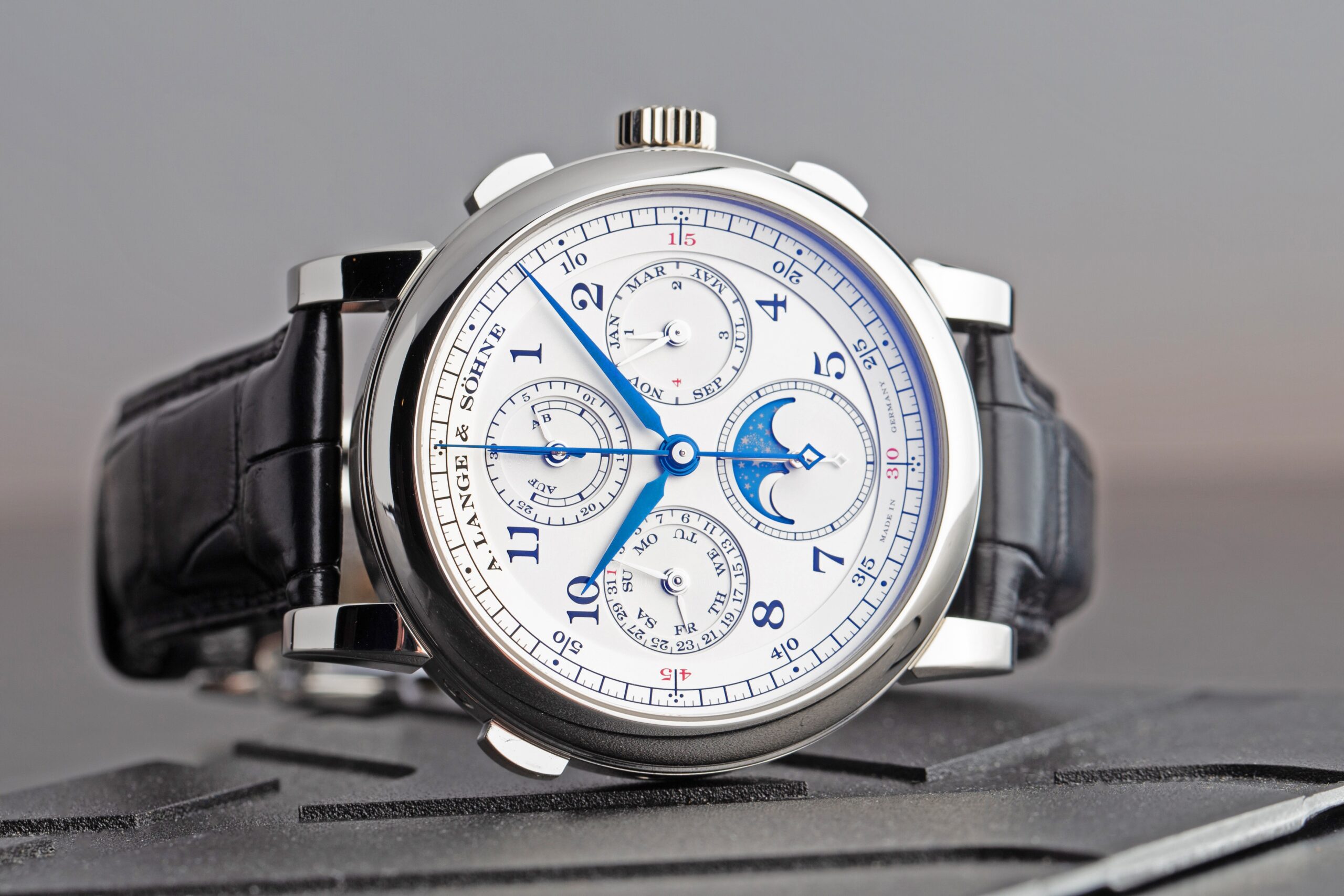
In addition to the three production pieces mentioned above, A. Lange & Söhne introduced the 1815 Rattrapante Perpetual Calendar Handwerkskunst in 2017 with a special event in Florence. This edition is possibly one of the most elaborate and ostentatious watches ever made by A. Lange & Söhne, limited to just 20 pieces and initially retailed at €290k.
Now, let’s turn our attention to the more intriguing part of the watch: caliber L101.1.
Caliber L101.1
As with every chronograph mechanism from A. Lange & Söhne, the caliber L101.1 of the 1815 Rattrapante Perpetual Calendar is a true delight. It has its flaws, but boy isn’t it good looking! The movement was conceived in 2010 and was introduced in 2013. The movement offers 42 hours of power reserve, beats at a traditional 3Hz and consists of 631 parts.
From a technical standpoint, similar to its dial side, the caliber L101.1 of the 1815 Rattrapante Perpetual Calendar doesn’t offer any groundbreaking innovations. It’s a modernly constructed split-seconds chronograph movement, bearing a striking resemblance to those built by Habring over Valjoux 7750. Like Habring’s construction, the 1815 Rattrapante Perpetual Calendar’s chronograph mechanism is operated via three pushers instead of the more traditional crown-based system. In my view, this creates a disparity between the watch’s outward appearance and its inner workings. I would have preferred a monopusher system. Then again, I must confess that this solution somewhat feels more German.
The heart of the 1815 Rattrapante Perpetual Calendar, like almost any chronograph for that matter, is the column wheel. When the user presses the start button, the column wheel rotates forward and pushes the tail of the clutch lever between the pillars. This action causes the clutch wheel to move horizontally and engage with the chronograph wheel. To stop, pressing the button again causes the clutch lever to disengage from the chronograph mechanism and return to its position between the pillars.
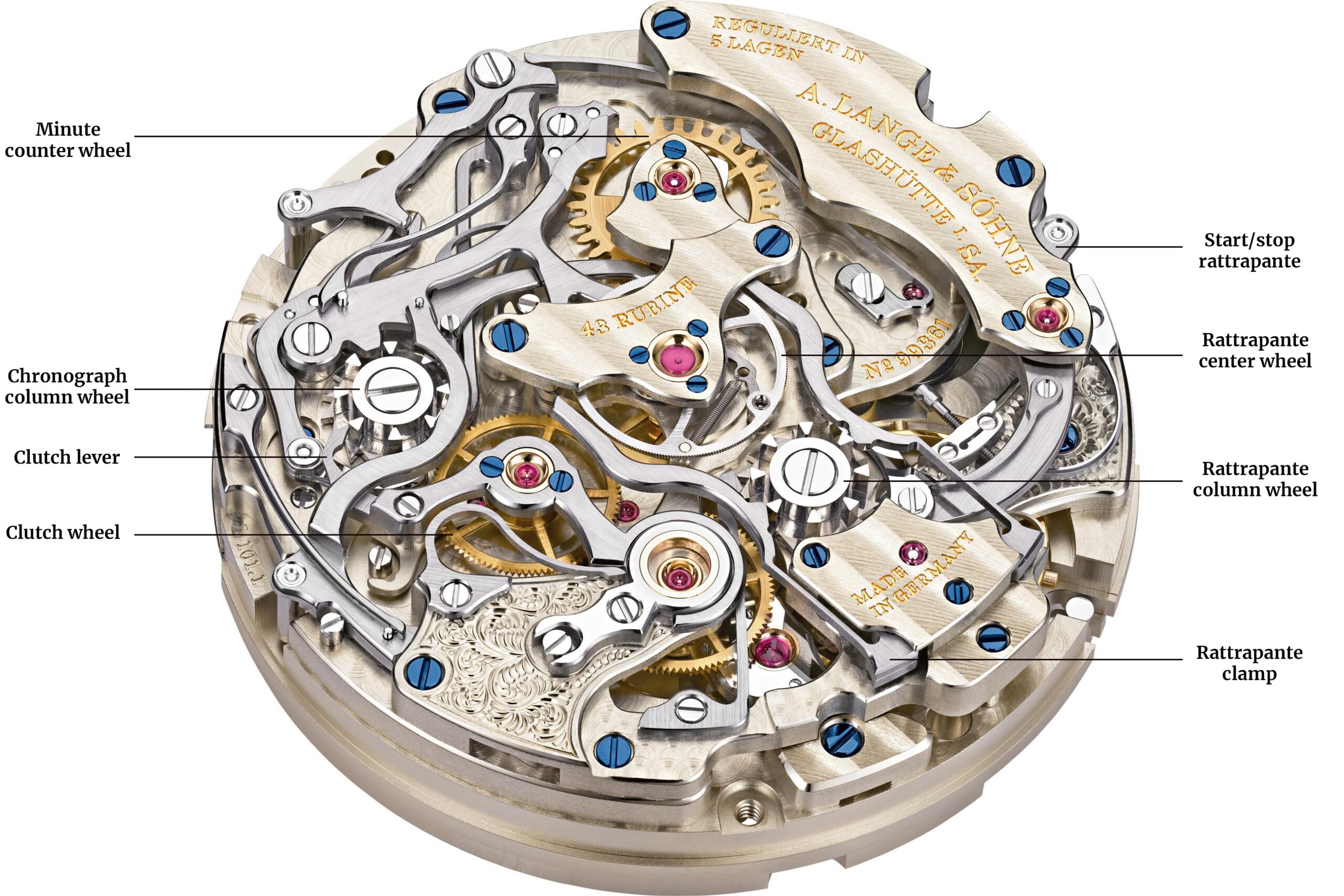
The 1815 Rattrapante Perpetual Calendar features two hands positioned on interlocking shafts. In simple terms, activating the rattrapante while the chronograph is running blocks the rattrapante gear. Upon release, similar to the flyback function, the rattrapante wheel spins to rejoin the main chronograph hand and aligns on top of it. When the rattrapante pusher is activated, the column wheel responsible for the clamp rotates one step, closing the clamp and halting the rattrapante center wheel. Pressing the pusher again opens the rattrapante clamp, allowing the rattrapante hand to instantly synchronize with the running chronograph hand.
A spring in the rattrapante center wheel ensures synchronization between the hands (chronograph + rattrapante). Upon release of the clamp, the rattrapante wheel (+ hand) jumps back to the position of the chronograph hand. The chronograph + rattrapante section of the 1815 Rattrapante Perpetual Calendar comprises 136 parts. Achieving precise operation of all these wheels and levers with each push requires exceptional dexterity.
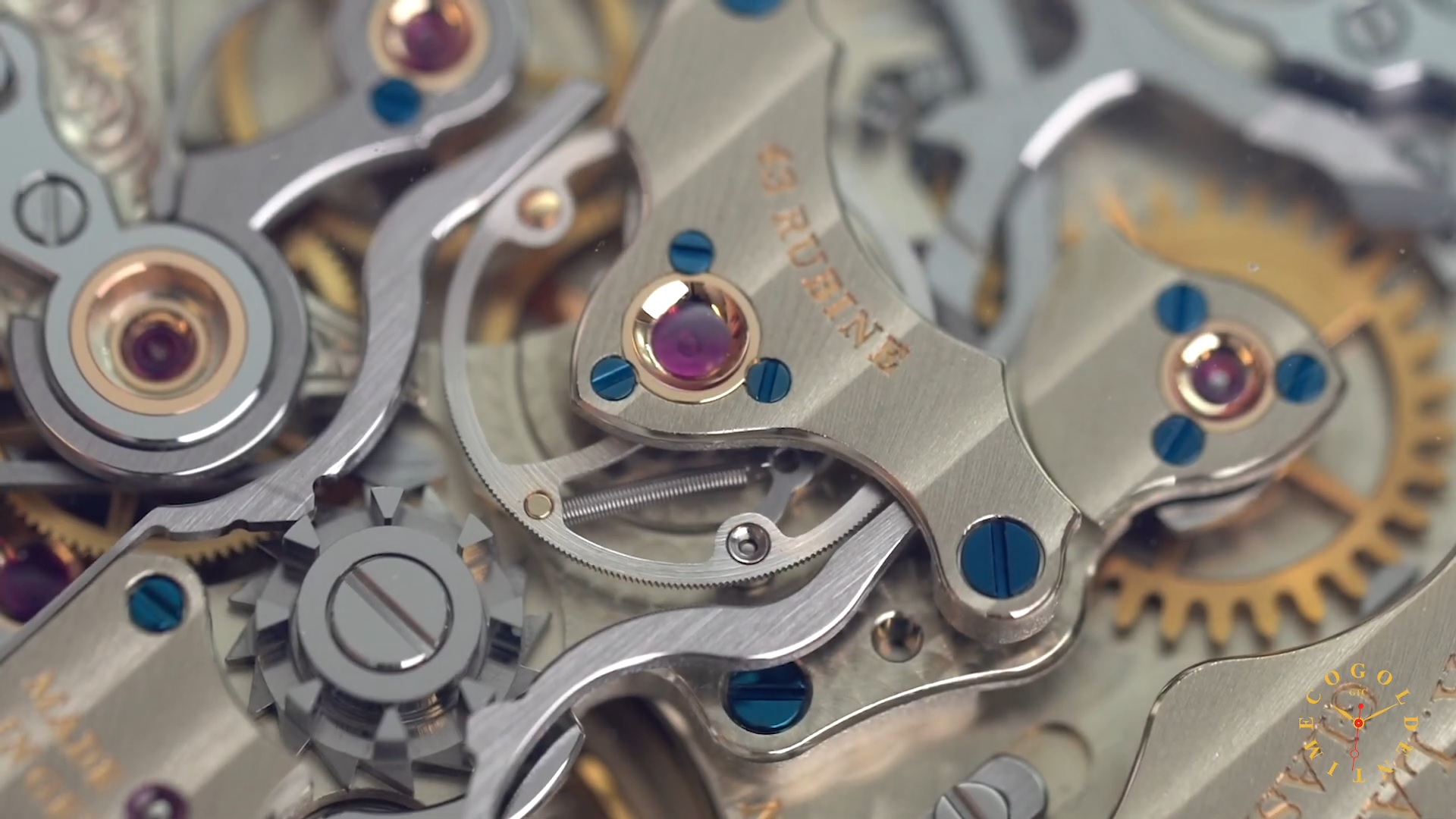
Pincers and springs. Courtesy of Lange Uhren GmbH
One stark visual difference that you would recognize in 1815 Rattrapante Perpetual Calendar’s caliber L101.1 from other chronograph pieces of Lange such as the Datograph or Triple Split, etc. is the lack of depth, and the flatness of the bridges and levers. This was done to keep the thickness of the watch at a wearable level. Although this sacrifices from the visual depth that we are used to from A. Lange & Söhne, it keeps 1815 Rattrapante Perpetual Calendar at an understandable 14.7 mm thickness.
In comparison, we have Patek Philippe. The current 5204R measures 40.2 mm in diameter and 14.3 mm in thickness. It features a truly traditional rattrapante mechanism with a crown-pusher. The 0.4 mm difference in diameter between the 5204R and the 1815 Rattrapante Perpetual Calendar is negligible, especially considering the better ratio of diameter to thickness of the 1815 model, making it sit more comfortably on the wrist. However, the Patek Philippe 5204 offers almost 50% more power reserve, beats at 4Hz, incorporates an isolator mechanism, and is made of almost 50% fewer parts than its Lange counterpart—an indication of Patek Philippe’s expertise in movement construction that is unfortunately often disregarded by Lange enthusiasts.
Of course, I’m leaving the Patek Philippe 5372 out of the equation; that watch and its mechanism are simply in a league of their own, beyond comparison.
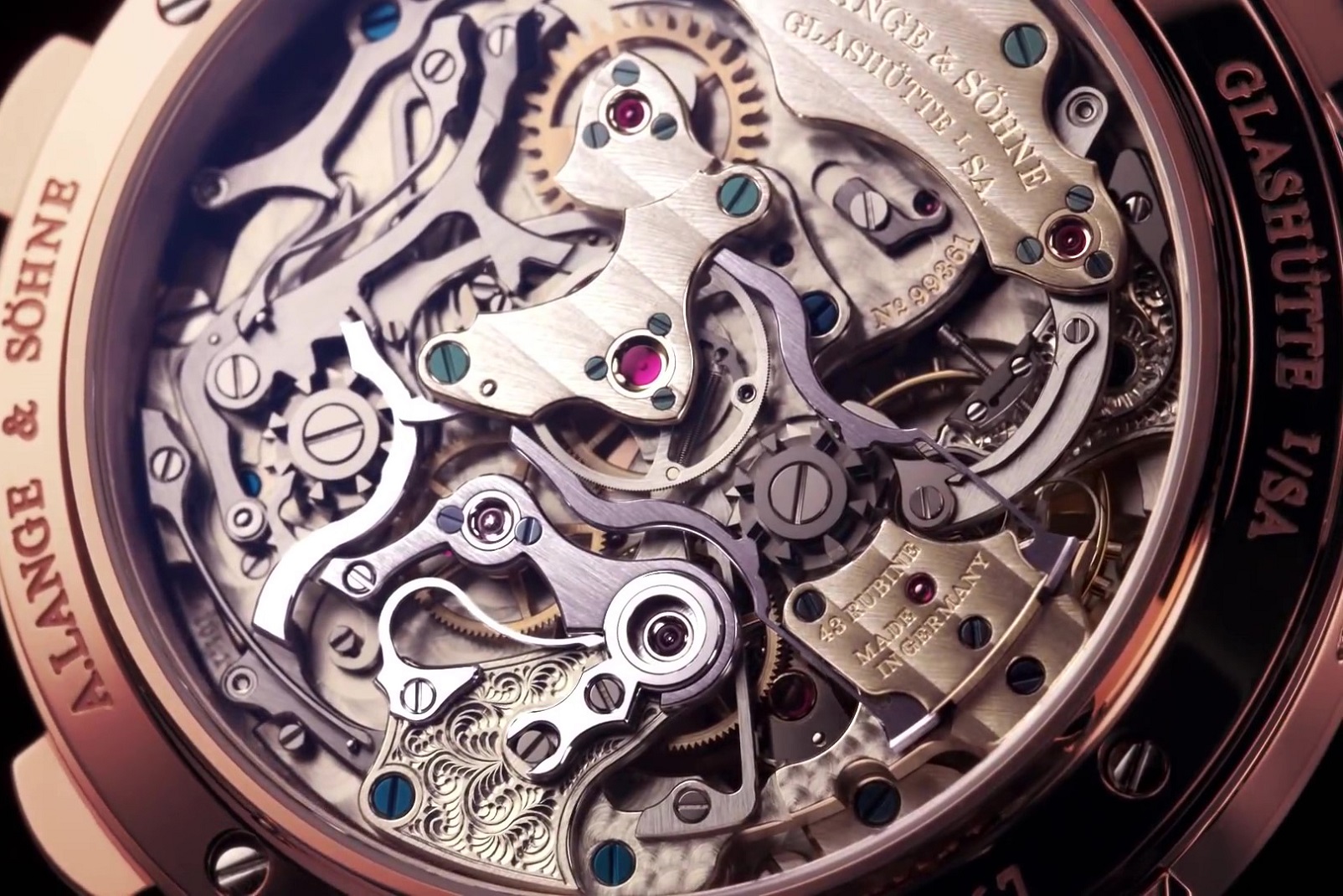
Despite the caliber L101.1 lacking depth, it remains a brilliant movement showcasing various finishing techniques in harmony. The dynamic chronograph components such as levers and the rattrapante clamp are crafted from steel and brushed, while signature parts like the column wheel are flat polished, creating a striking contrast with the understated surfaces. Additionally, the beautifully shaped and beveled central bridge adorned with two gold chatons and stripes adds a touch of elegance. Even the balance cock, though hardly visible, is hand-engraved, underscoring A. Lange & Söhne’s meticulous attention to detail and reverence for its own handcraft tradition.
Buying an A. Lange & Söhne 1815 Rattrapante Perpetual
All things considered, the 1815 Rattrapante Perpetual Calendar is a remarkable timepiece. It stands alone in the market, offering a true, traditional interpretation of such a combination. While it may not appeal to everyone, it’s an obvious choice for many. Moreover, it’s undeniable that it’s exceptionally well-crafted and displays expertise in its construction.
My only qualm with the watch lies in its discordance between its appearance and operation. A watch with such a traditional starting point deserves a movement construction to match, namely a crown-pusher for the rattrapante.
There are only a few modern alternatives to this piece. One notable option is the Patek Philippe 5204, which, in my opinion, boasts superior case design, legibility, and technical prowess. On the other hand, there’s the Habring Perpetuel Doppel, offering the best value for the complication. Fortunately for collectors, these three pieces offer completely different values in terms of design and price, allowing the choice to be purely based on taste and budget.
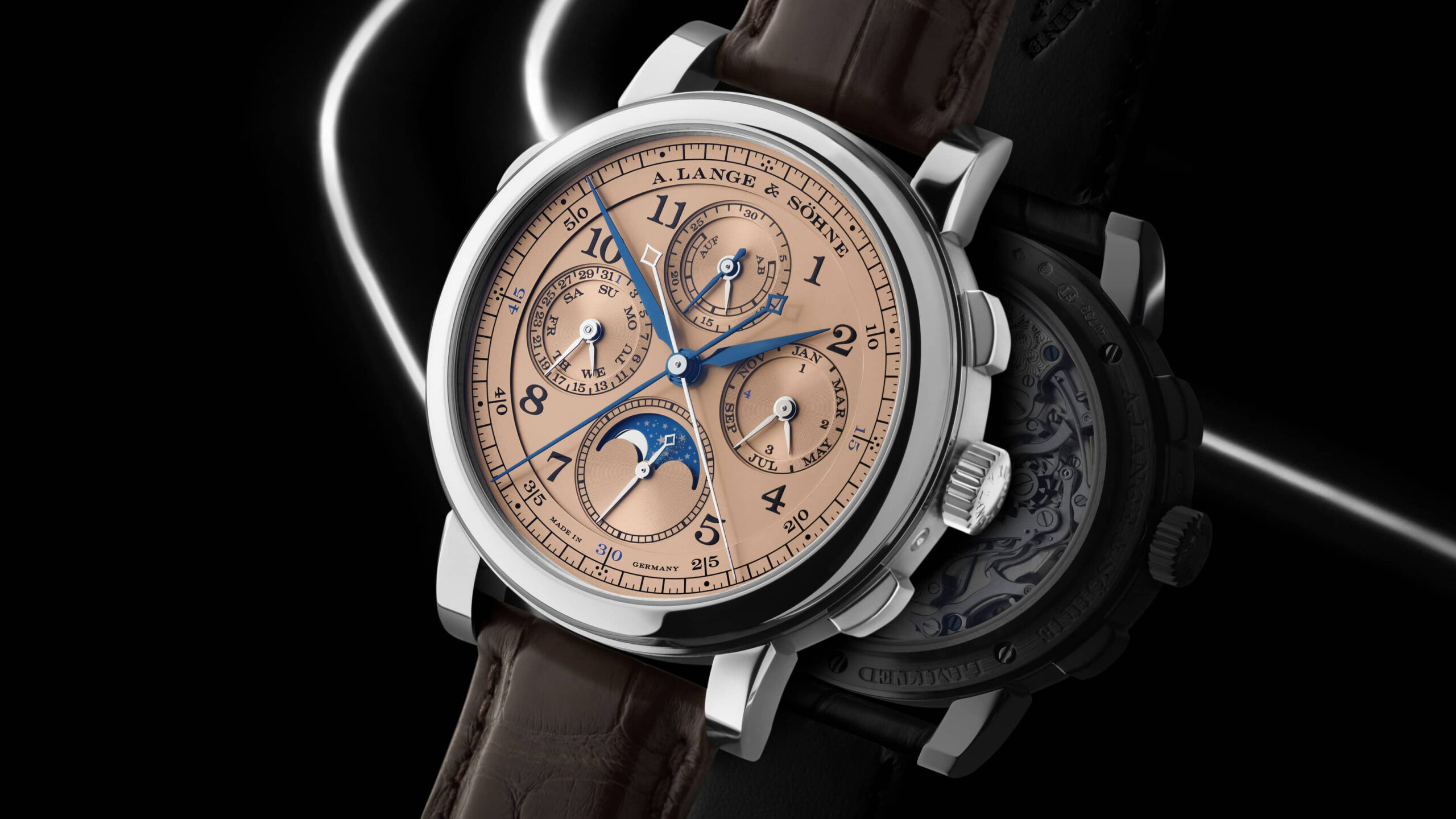
1815 Rattrapante Perpetual Calendar with pink gold dial. Limited to 100 pieces. Courtesy of Lange Uhren GmbH
As of 2023, the 1815 Rattrapante Perpetual Calendar’s MSRP was at $253k for the platinum and $230k for the pink gold variants. However, with the introduction of the 421.056 with pink gold dial, we are greeted with $319k, which tells me that if you go to the boutique, you are going to see a similar pricing for the other two.
However, both versions (platinum and pink gold) can easily (with a bit patience) be found for around $145k and $130k in the secondary market. Thinking that the aforementioned rivals such as 5204P or 5204R is almost 1/3 above in price, an 1815 Rattrapante Perpetual in pre-owned market is just a tremendous bargain for what it is.
Habring on the other hand offers the absolutely best value at €21,5k for a split-seconds perpetual calendar watch. Obviously, it is not as elaborately finished nor detailed as the other two. But it is surely a watchmaking marvel and a homerun for those who just want the complication.
Thank you for reading.
I hope this was a valuable guide for whomever is looking for an 1815 Rattrapante Perpetual Calendar or just want to learn the details and history of these pieces. If you’d like to chat, sell or buy an 1815 Rattrapante Perpetual Calendar, please kindly reach out to me via [email protected]
Please feel free to contact:
Follow Langepedia on Instagram:
Watch “A. Lange Story” Documentary, in partnership with WatchBox:
FAMILIES / COMPLICATIONS
STAY IN TOUCH
Sign up for the newsletter to get to know first about rare pieces at Marketplace and in-depth articles added to the encyclopedia, for you to make the most informed choice, and first access!